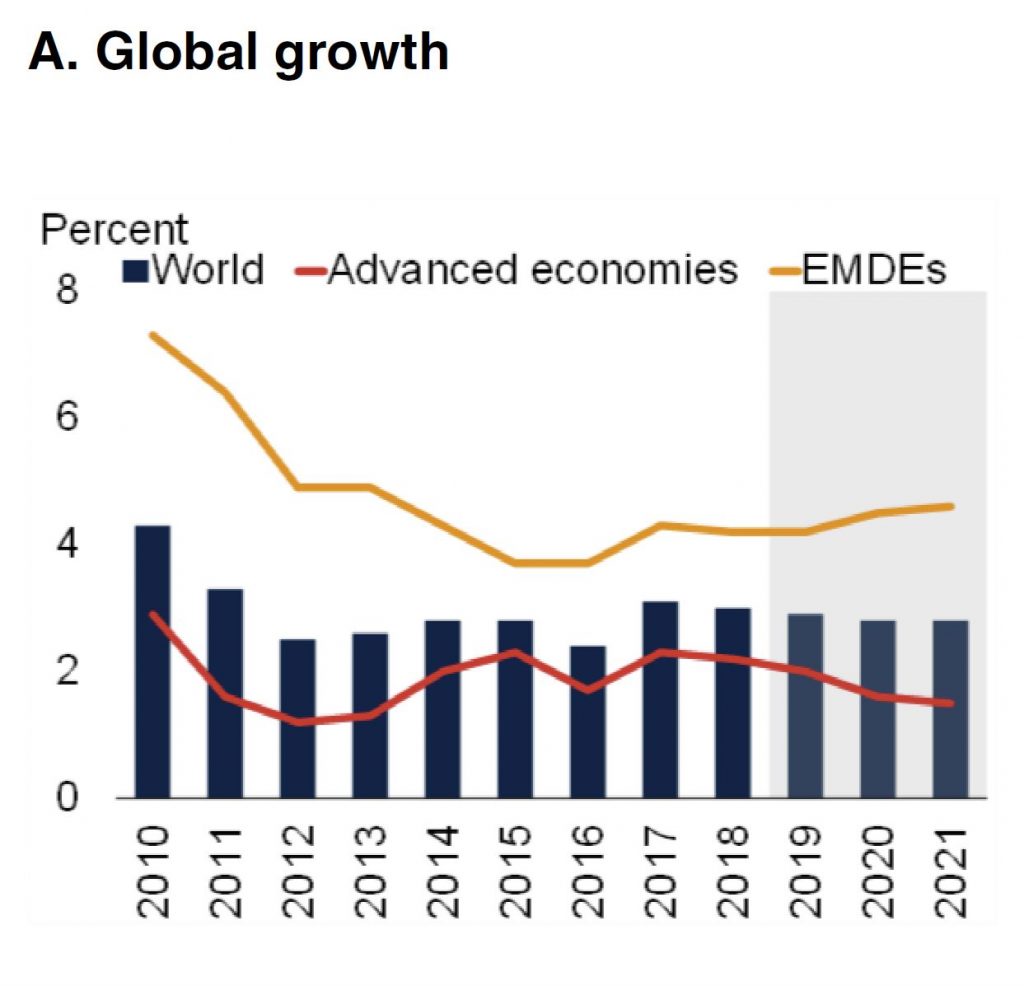The latest edition of the World Bank Global Economics Prospects Report, January 2019, says global growth is moderating as the recovery in trade and manufacturing activity loses steam. Despite ongoing negotiations, trade tensions among major economies remain elevated.

These tensions, combined with concerns about softening global growth prospects, have weighed on investor sentiment and contributed to declines in global equity prices. Borrowing costs for emerging market and developing economies (EMDEs) have increased, in part as major advanced-economy central banks continue to withdraw policy accommodation in varying degrees. A strengthening U.S. dollar, heightened financial market volatility, and rising risk premiums have intensified capital outflow and currency pressures in some large EMDEs, with some vulnerable countries experiencing substantial financial stress. Energy prices have fluctuated markedly, mainly due to supply factors, with sharp falls toward the end of 2018. Other commodity prices—particularly metals—have also weakened, posing renewed headwinds for commodity exporters.
Economic activity in advanced economies has been diverging of late. Growth in the United States has remained solid, bolstered by fiscal stimulus. In contrast, activity in the Euro Area has been somewhat weaker than previously expected, owing to slowing net exports. While growth in advanced economies is estimated to have slightly decelerated to 2.2 percent last year, it is still above potential and in line with previous forecasts.

EMDE growth edged down to an estimated 4.2 percent in 2018—0.3 percentage point slower than previously projected—as a number of countries with elevated current account deficits experienced substantial financial market pressures and appreciable slowdowns in activity. More generally, as suggested by recent high-frequency indicators, the recovery among commodity exporters has lost momentum significantly, largely owing to country-specific challenges within this group. Activity in commodity importers, while still robust, has slowed somewhat, reflecting capacity constraints and decelerating export growth. In low-income countries (LICs), growth is firming as infrastructure investment continues and easing drought conditions support a rebound in agricultural output. However, LIC metals exporters are struggling partly reflecting softer metals prices. Central banks in many EMDEs have tightened policy to varying degrees to confront currency and inflation pressures.
In all, global growth is projected to moderate from a downwardly revised 3 percent in 2018 to 2.9 percent in 2019 and 2.8 percent in 2020-21, as economic slack dissipates, monetary policy accommodation in advanced economies is removed, and global trade gradually slows. Growth in the United States will continue to be supported by fiscal stimulus in the near term, which will likely lead to larger and more persistent fiscal deficits. Advanced-economy growth will gradually decelerate toward potential, falling to 1.5 percent by the end of the forecast horizon, as monetary policy is normalized and capacity constraints become increasingly binding.
They show that there have been previous periods of low inflation during the Bretton Woods fixed exchange rate system in the post-war period up to the early 1970s, and during the gold standard of the early 1900s.

Softening global trade and tighter financing conditions will result in a more challenging external environment for EMDE economic activity. EMDE growth is expected to stall at 4.2 percent in 2019—0.5 percentage point below previous forecasts, partly reflecting the lingering effects of recent financial stress in some large economies (e.g., Argentina, Turkey), with a sharply weaker-than-expected pickup in commodity exporters accompanied by a deceleration in commodity importers. EMDE
growth is projected to plateau at an average of 4.6 percent in 2020-21, as the recovery in commodity exporters levels off. Per capita growth will remain anemic in several EMDE regions—most notably, in those with a large number of commodity exporters—likely impeding further poverty alleviation.

The projected gradual deceleration of global economic activity over the forecast horizon could be more severe than currently expected given the predominance of substantial downside risks. A sharper-than-expected tightening of global financing conditions, or a renewed rapid appreciation of the U.S. dollar, could exert further downward pressure on activity in EMDEs, including in those with large current account deficits financed by portfolio and bank flows.
Government and/or private sector debt has also risen in a majority of EMDEs over the last few years, including in many LICs, reducing the fiscal room to respond to shocks and heightening the exposure to shifts in market sentiment and rising borrowing costs.
Escalating trade tensions are another major downside risk to the global outlook. If all tariffs currently under consideration were implemented, they would affect about 5 percent of global trade flows and could dampen growth in the economies involved, leading to negative global spillovers.
While some countries could benefit from trade diversion in the short run, rising trade protectionism would stifle investment and severely disrupt global value chains, contributing to higher prices and lower productivity. Other downside risks—such as heightened political uncertainty, escalating geopolitical tensions, and conflict—further cloud the outlook.
Even though the probability of a recession in the United States is still low, and the slowdown in China is projected to be gradual, markedly weaker-than-expected activity in the world’s two largest economies could have a severe impact on global economic prospects. Stimulus measures have bolstered the near-term outlook in these two countries but could contribute to a more abrupt slowdown later on. A simultaneous occurrence of a severe U.S. downturn and a sharper-than expected deceleration in China would significantly increase the probability of an abrupt global slowdown and thus negatively impact the outlook of other EMDEs through trade, financial, and commodity market channels. A global downturn would be particularly detrimental for those EMDEs with reduced policy space to respond to
shocks.
The softening outlook and heightened downside risks exacerbate various challenges faced by policymakers around the world. Advanced economies should use this period of above potential growth to rebuild macroeconomic policy buffers and lay the foundation for stronger growth with reforms that bolster potential output. Care should be taken to avoid shifts in trade and immigration policies that could negatively affect longer-term growth prospects, both domestically and abroad. A renewed commitment to a rulesbased international trading system would also help bolster confidence, investment, and trade.
In a context of limited policy buffers, EMDE policymakers need to bolster the capacity to cope with possible bouts of financial market volatility, including sharp exchange rate movements—while undertaking measures to sustain the ongoing period of historically stable inflation. This immediate priority will require a credible commitment to price stability from central banks, underpinned by strong institutional in dependence, as well as efforts by regulators and prudential authorities to reduce persistent financial fragilities. EMDEs also face substantial fiscal challenges and the risk of worsening debt dynamics as global financing conditions tighten.
For many EMDEs, it will be imperative to restore fiscal space given cyclical conditions, as well as address the vulnerabilities associated with elevated foreign-currency-denominated debt.
Equally critically, amid a projected deceleration in potential growth, EMDEs face the pressing challenge of ensuring sustained improvements in living standards.
This will require investments in human capital and skills development to raise productivity and take full advantage of technological changes. In the current environment of limited fiscal resources, the urgency of these investments highlights the critical need to prioritize effective public spending and increase public sector efficiency.
Moreover, facilitating the expansion of small- and medium-sized enterprises, including by improving their access to international markets and finance, would also spur productivity and stimulate growth -enhancing investments. For many EMDEs, there is scope to further liberalize trade and improve the extent to which they are integrated into global value chains, which would foster a more efficient allocation of resources, job creation, and export diversification. Policies that help improve outcomes in these areas would also contribute to address the challenges associated with informality, thus reinforcing the basis for future productivity growth.
